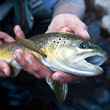There are distinct advantages offered by fast action rods that don't come in slower packages. They allow for easy and authoritative line pickup, have the ability to toss heavy lines and tips, are much more adept at casting in the wind, allow the caster to throw tighter loops, generally help increase aim and accuracy and -- of course -- pack more power than their slower bretheren, allowing for longer and quicker casts. Despite all of these advantages, I've made no secret of the fact that I'm not generally a fast-action rod fan.
I've criticized rod makers for taking the fast-action trend too far and many a fly fisherman for buying into the idea that fast action rods are the best rod for virtually any job. Though the advantages of fast-action rods are numerous, those advantages have always been accompanied by tradeoffs, tradeoffs which have come in the form of decreased responsiveness or feel, poor performance in close and increased difficulty of casting. All of these tradeoffs, for the most part, are symptoms of the same characteristic of fast-action rods: their stiffness and tendency towards tip-flex.
Given such, I've typically treated fast and ultra-fast rods as saltwater implements. Fast action rods shine in the salt, as all of their virtues are assets to the saltwater fly fisherman and their tradeoffs don't matter much, since you're not typically fishing in close. I've still not loved fishing them, finding most of them to be overly rigid and often somewhat lifeless. But, in the salt, the tradeoffs were reasonable ones due to the advantages provided to an intermediate caster such as myself. On a trout stream, however, I've never much understood the fast action craze. In the Sage world, the Z-Axis made sense (considered fast action when released, but not by today's standards), but the TCR and even the much-improved TCX felt very much out of place. Fast action rods from other manufacturers were no exception. Everyone seemed to love Hardy's SINTRIX offerings, like the Zenith, but it didn't do much for me.
In all fairness, I didn't fish any of those rods on trout streams all that much. I didn't want to. They didn't provide a compelling reason to do so. And it wasn't just me. Other casters noticed and so did the rod makers. The result has been concerted efforts from companies like Sage, Scott and others to design rods that bring forth the advantages of fast action rods while dismissing or at least subduing the disadvantages. I've somewhat embarrassingly yet to spend any time with Scott's "Fast Meets Feel" Radian, but after fishing Sage's METHOD for the last six or so months, it is clear that rod makers like Sage's Jerry Siem are making big strides in moving fast action rods closer to true "all-water" status.
What Works
The METHOD, as expected, delivers a great deal of power. Throwing long casts is effortless, when compared to even medium-fast action rods, as one would expect it to be. Also as expected and noted, it shined in the salt. Picking 60 feet of line off the water and quickly delivering 80-90 feet of line forward with a single backcast is accomplished with relative ease, and doable even for the intermediate caster, dealing with even stiff headwinds was a relative pleasure, especially when compared to the considerable frustration that resulted from trying to do so with some of the other rods on the boat those days.
Unlike its predecessors, though, I found the METHOD to offer up that power without the learning curve of other fast action rods and while offering up a considerable amount of responsiveness and feel.
When picking up any fast action rod, most casters will immediate notice that their timing is off and errors are magnified. Fast rods are usually unforgiving. It is harder to sense the timing of the cast in the feel of the rod due to its stiffness which results in less of the rod's load being in butt of the rod and thus less tangible in the hand. At least, that how I make sense of it. I won't claim to be an expert on rod design or casting mechanics but I certainly understand the core concepts at work and how they translate into changes in my casting.
This unforgiving nature of fast action rods are part of why they're so difficult for novice casters to use. There's a great deal of fly casting that can only be learned by feel, and fast action rods have typically offered little of it. I've literally handed fast action rods to first time casters, had them try to load and make sense of the casting motion with it, quickly get frustrated and dismiss the entire pursuit as maddening nonsense.
For my part, the METHOD offers a great deal more responsiveness and feel than any of the other fast action rods I've casted. Though I have no idea whether or not the METHOD loads deeper in the rod than the TCX or other ultra-fast implements, it most certainly feels like it does. This not only makes it easier to feel and time your cast but aim it as well, and the result for me was all-around improved casting. The METHOD is also a much better in-close performer than rods of its class that I've casted, due mostly to the fact that you can load and cast the METHOD with less line out of the tip than fast-action rod owners are likely accustomed to.
What Doesn't
It's hard to imagine that Sage doesn't feel it has achieved its goal with the METHOD series. The rods offer a great deal of power and versatility, two characteristics that don't often come together in the world of fly rods. Still, the METHOD is still a tool that still may present challenges to the novice caster -- though to a much lesser degree than earlier generations of fast and ultra-fast actions -- and in fairness to Sage, they're not marketing it as a beginner's tool.
Likewise, if you're spending 95% of your time fishing dries small and medium sized trout streams, then the METHOD probably shouldn't be your first choice.
Final Word
Does the METHOD with its increased versatility represent a rod that could serve as a one-rod quiver for the intermediate to advanced caster that fishes in a diverse array of conditions? I'm not sure. What I can say with confidence is that it gets closer to doing so than any other fast action rod that I've spent time with and for the first time I find myself looking at a rod this fast as a trout fisherman's tool.
As a saltwater tool, there's currently no rod that I've cast that I'd rather have with me on the flats, in the surf, on the bow of a skiff or tossing sinking lines off a jetty. While Sage doesn't classify the METHOD as a saltwater rod, due to the fact that the series includes a diverse array of rod offerings -- including 21 different rod models in the single hand, switch and spey genres -- make no mistake, the METHOD will be many a saltwater fly fisherman's dream rod.






























Comments
Janos replied on Permalink
I have hardly had any experience before with high end fly rods, but I happened to win a Method 890 on a fly casting competition.
I'm just getting familiarized with it, but I can say, that it's an absolutely impressive rod in many ways.
As for weight, it feels as a slender #6-er, you can keep casting for hours with no fatigue. As for strength, it feels like a tough #8-er, but loads fine even with #7 line, and delivers the #9 line too, without any difficulty. It was easy to get used to, my loops became tighter from the first outing, and didn't experience any trouble, that usually told about fast rods.
I mostly do streamer fishing on a large river, typical casting range is 50-80 feet, and found the METHOD an ideal tool for this purpose.
Jack O'dowd replied on Permalink
Wow, a new sage model. Doesn't time fly? I didn't realize a month could pass so fast............and let me guess, it's faster,more accurate,longer and is .01 of a gram lighter than its predecessors?
Mark Hoffman replied on Permalink
I got my Method 790-4 as a last one in stock in the shop about 9 years ago. It has been used in saltwater almost exclusively. In the first year it caught the 3 biggest fish of my fly fishing career. It was fun with a 500 gram Kahawai and a worthy weapon against a 83cm Yellowtail Kingfish on an estuary flat. It puts a line into and across gusty coastal winds like no other rod I've owned. One day I hope to take to a lake or river and see how trout will bow down before it's undoubted power!
Pages